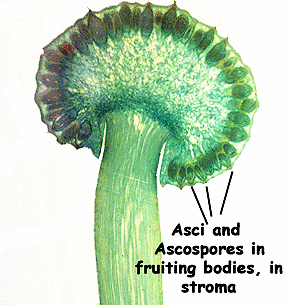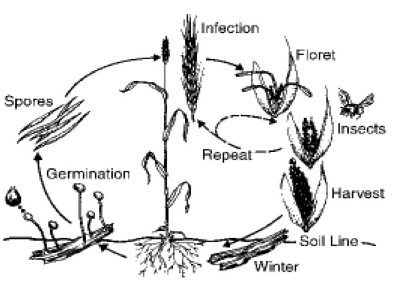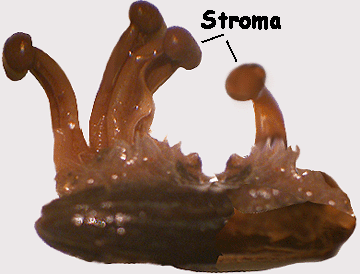Can You Feel the Love? (Reproduction)
HOW DOES CLAVICEPS PURPUREA REPRODUCE?
Reproduction in the fungi is really neat, but also very complex.
This is especially true of the members of the Ascomycota, like
Claviceps purpurea, because they reproduce both sexually and
asexually. To give you a better understanding of the general
reproduction in the Ascomycota, I'll talk about the general
methods of reproduction in this phylum. Sexual reproduction
occurs when two compatible mycelia undergo plasmogamy. This just
means that they fuse their cytoplasm together, but they DO NOT
fuse their nuclei quite yet. This means that the cells are in
the dikaryotic, or "N+N" stage; a state found only in the fungi.
From here,
 the fungi grow until
an environmental factor tells
them to make a fruiting body. Within the fruiting body we have karyogamy, the fusion of the nuclei, and then the ascospores are
produced in the ascus after the newly diploid cell undergoes one
round of meiosis followed by one round of mitosis to form eight
ascospores. These spores are then released into the environment
where they can germinate. Like I stated above, there is also asexual reproduction that takes place. When we
have asexual reproduction, the fungi produces conidia where they
produce spores by simple mitosis.
the fungi grow until
an environmental factor tells
them to make a fruiting body. Within the fruiting body we have karyogamy, the fusion of the nuclei, and then the ascospores are
produced in the ascus after the newly diploid cell undergoes one
round of meiosis followed by one round of mitosis to form eight
ascospores. These spores are then released into the environment
where they can germinate. Like I stated above, there is also asexual reproduction that takes place. When we
have asexual reproduction, the fungi produces conidia where they
produce spores by simple mitosis.
WHAT IS LIFECYCLE OF ERGOT LIKE?
The lifecycle of this organism is quite complex, like that of most
members of the fungi. To describe the lifecycle, I will start with
the sclerotium, which is the
hardened mass of the fungus' mycelia.
The sclerotium is more resistant that normal mycelia, which is important
because this
is the structure that needs
to survive through the winter months. Winter is an important season
for
this organism and it does best when it has one to two months of
cold. When the birds start to chirp and the soil is very moist, the
"ergots" start germinating and creating the club-headed fruiting
bodies, called stroma. In the fruiting bodies, we have karyogamy and sexual
reproduction as described above. These spores are
then released through a small hole, called the ostiole, in the perithecium. The spores are then carried by the wind to the flowers
of the the open-pollinated grasses. If the plant has not yet been
fertilized, Claviceps purpurea infects its host.
through the winter months. Winter is an important season
for
this organism and it does best when it has one to two months of
cold. When the birds start to chirp and the soil is very moist, the
"ergots" start germinating and creating the club-headed fruiting
bodies, called stroma. In the fruiting bodies, we have karyogamy and sexual
reproduction as described above. These spores are
then released through a small hole, called the ostiole, in the perithecium. The spores are then carried by the wind to the flowers
of the the open-pollinated grasses. If the plant has not yet been
fertilized, Claviceps purpurea infects its host.
 Once it gets
settled in to its new home, it starts
to produce structures, called conidia, about a week after infection. Conidia are where the asexual
spores are produced externally. Claviceps purpurea produces them in
abundance so it can spread to as many plants as possible. It also
produces a thick, sticky liquid called honeydew that mixes with the
spores so the spores can also be spread by insects. When their time
is up, the hardened ergots fall to the ground and start the whole
process over again!
Once it gets
settled in to its new home, it starts
to produce structures, called conidia, about a week after infection. Conidia are where the asexual
spores are produced externally. Claviceps purpurea produces them in
abundance so it can spread to as many plants as possible. It also
produces a thick, sticky liquid called honeydew that mixes with the
spores so the spores can also be spread by insects. When their time
is up, the hardened ergots fall to the ground and start the whole
process over again!
WHAT MAKES REPRODUCTION AND DISTRIBUTION MORE EFFECTIVE?
Claviceps purpurea is a very serious human pathogen and history
shows us how it can create HUGE problems if left unchecked, which
makes it important to know when to be most on our guard to wa tch out
for this fungus. Having cool, wet springs is not good because it
signals the ergots to germinate and it also delays the process of
fertilization. Delaying fertilization is bad because the
unfertilized ovaries are the most susceptible to becoming infected
with the ergot fungus, in comparison to the pollinated ovaries. For
this same reason, having a lot of male sterile plants is bad because
there is no pollen being produced. Male sterility is most common in
soils that are copper deficient.
tch out
for this fungus. Having cool, wet springs is not good because it
signals the ergots to germinate and it also delays the process of
fertilization. Delaying fertilization is bad because the
unfertilized ovaries are the most susceptible to becoming infected
with the ergot fungus, in comparison to the pollinated ovaries. For
this same reason, having a lot of male sterile plants is bad because
there is no pollen being produced. Male sterility is most common in
soils that are copper deficient.
To continue on to learn even MORE awesome stuff, go to the HABITAT page! Otherwise, click back to HOME.